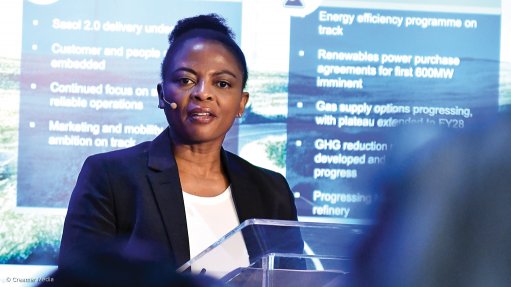
Sasol energy business VP Priscillah Mabelane
Photo by: Creamer Media Chief Photographer Donna Slater
Sasol energy business VP Priscillah Mabelane reports that the JSE-listed group has identified three priority clusters for the roll-out of its green hydrogen strategy, while also supporting government with plans to develop Boegoebaai, in the Northern Cape, into a green hydrogen and derivatives export hub.
Speaking at the South Africa Green Hydrogen Summit in Cape Town, Mabelane said Secunda, the Vaal Triangle and Saldanha Bay had been selected for various initiatives, with specific green-steel-related projects being pursued in partnership with ArcelorMittal South Africa in the Vaal Triangle and Saldanha Bay.
Sasol was pursuing an initial sustainable aviation fuel (SAF) opportunity, known as the HyShiFT programme, in Secunda in partnership with Linde, Enertrag and Hydregen, which will bid to secure support under Germany’s H2Global platform.
Mabelane says the group has a longer-term vision to transform the OR Tambo International Airport into a global sustainable aviation hub.
Enertrag new energy solutions head Dr Tobias Bischof-Niemz, who also spoke at the summit, said the installed Fischer Tropsch (FT) capacity at Secunda positioned Sasol with a significant “first-mover advantage”, given that Secunda was the only FT plant globally already producing a certified aviation fuel based on grey hydrogen.
The H2Global mechanism was likely to prove crucial in unlocking the advantage, however, given that green hydrogen was a commodity, which meant it faced a “first mover disadvantage”, with later movers benefitting from the technology learnings of early adopters.
Should the project receive such support, the HyShiFT programme would seek to displace 1% of the grey hydrogen currently used at Secunda with green hydrogen, which would be produced using a 200 MW electrolyser and 450 MW of renewable electricity to be produced in Mpumalanga.
The green hydrogen would be used in Sasol’s FT reactors to produce a certified SAF.
In the Vaal Triangle cluster, meanwhile, Sasol was partnering with ArcelorMittal South Africa to investigate the production of green hydrogen for use in steelmaking, and the capturing of unavoidable carbon dioxide.
Sasol was also assessing the potential to supply other industries in the region, which currently use grey hydrogen in their production processes.
The group is also repurposing an existing 60 MW electrolyser in Sasolburg to produce green hydrogen that will be used to pilot other green-mobility projects in partnership with the Industrial Development Corporation, including some Toyota Mirani fuel-cell vehicles and mine haulage trucks.
In time, Sasol will also look to transition the 500 000 t ammonia and methanol produced at Sasolburg from grey to green hydrogen.
In Saldanha, Sasol was also partnering with ArcelorMittal South Africa on a green steel project using green hydrogen, which could result in the re-opening of parts of the mothballed Saldanha Steel mill.
Meanwhile, President Cyril Ramaphosa offered an update on the Boegoebaai green hydrogen studies being facilitated by Sasol.
The President said significant progress had been made on a master plan for a green hydrogen special economic zone at Boegoebaai, with the aspiration to support 40 GW of electrolyser capacity by 2050.
Mabelane said Sasol’s green hydrogen strategy had two imperatives: “One is to anchor the local demand [and] the second part is to drive the green hydrogen hub facilitation.”